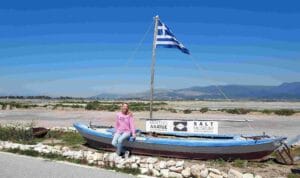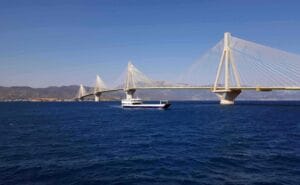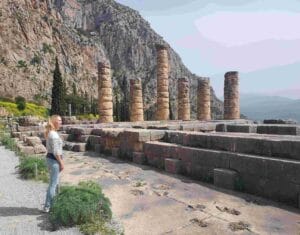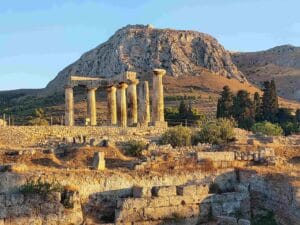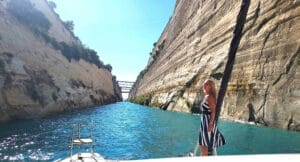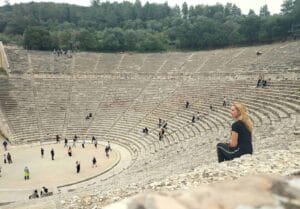‘Wow, we’re going to Ibiza!’, this song (1999) by the Vengaboys, I was singing a lot during the days before we would leave the mainland of Spain to sail to Ibiza. Gilles joined in sometimes, but also went a bit crazy from the song, because it lingers in your head (so opening the link is/was at your own risk 😊).
After sailing along the Spanish coastline for months now, we were excited to make the crossing to Ibiza with it’s beautiful bays.
Preparing the crossing to Ibiza
We checked the weather in Altea where we were at that time. Tuesday 14. February would be a good timing to sail to Ibiza, because of the wind force (at least 12 knots) and wind direction (NorthEast, anything but directly from the East would be fine enough for us).
The crossing from Altea to the most westerly harbor of Ibiza (Port de Sant Antoni de Portmany) would be 70 miles, and with an average speed of 5 knots, it would take at least 14 hours. This time of year, February, there are 11 hours of sunlight (7.30-18.30u), so it would mean partly sailing in the dark. To get the most time out of the daylight and arrive at daylight, we decided to start sailing at 22.00u. We didn’t want to rush, because we would cross a busy shipping lane with containerships and cruise ships in between the mainland of Spain and Ibiza. There are also many ferries active in this area and there could be fisher boats, so the 14 hours were expected to be the minimum sailingtime, it would more like 16 to 18 hours of sailing.

Sailing at night at the Mediterranean Sea
It’s always a challenge to sail in the dark: you have to rely 100% on your navigation equipment, because it’s pitch-black. I compare it to driving your car blindfolded 😊. During sailing, you can have a radar system activated on your screen, so anything that sticks above the water (higher than 50 centimeters) will turn red. When red appears on the screen on our sailing route, we immediately research what it can be: a boat, a buoy, just a wave or an unknown object? Any case, we avoid it by changeing course a bit.
We have a slogan during night sailing: ‘Black is good!’. If you see nothing during sailing, you are ok, how strange and contradictory that may sound and feel!
The shipping lane turned out to be very busy with containerships and cruise ships crossing. It was a wide area, so we had to wait a bit to make that crossing. Later in the morning, the wind changed direction to East and became less strong, so the total trip took 18 hours. We arrived at 16.00h at the harbor in Ibiza.
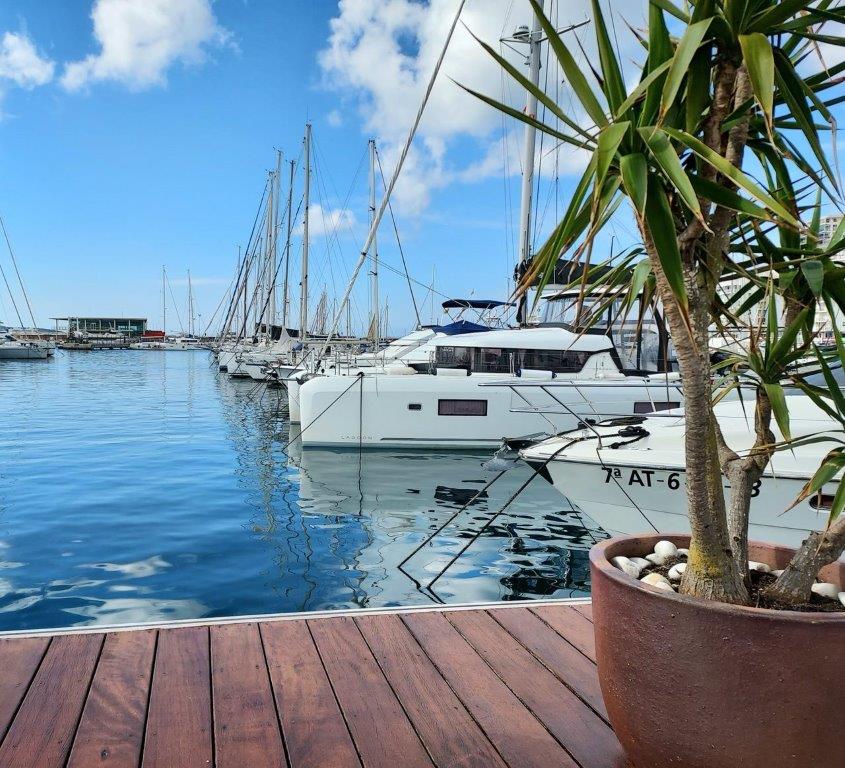
Welcome at Ibiza: cava for sailors!
When we sailed in the harbor at 16.00h, we saw the palm trees and people sitting on the boulevard in the sunshine. When we stepped on the quay, after 18 hours being at sea, awake and staring at the water, we were happy to be standing on land, ‘Wow, we’ve arrived at Ibiza!’.
The harbormaster welcomed us and she told us that every sailor arriving gets a free cava at the Club Nàutic Sant Antoni next door. So of course, we went next door. We toasted on our successful crossing. You can imagine, after walking back to the ship, organizing things a bit on the boat, having a meal and then sitting down, the lights went out at 21.00h (literally and figuratively) for a good night’s sleep. Accelerated a bit by the cava 😊.


North of Ibiza
We stayed 2 days in Port de Sant Antoni de Portmany 2 and explored the area with our bikes. We were surprised that behind the strip with all the restaurants, bars and shops, there was a so much nature at Ibiza! We cycled a long time in the woods and along the cliffs without seeing anybody. The watercolor was bright blue, green of even turquoise. It was sunny, the temperature was about 18-20C°.


After 2 days, we sailed further north along the coast of Ibiza and visited several bays or coves (in Spanish ‘cala’). During high season, you have to arrive in a bay early, otherwise it’s full with boats (and jet ski’s, rental boats and loud music….). Now we were often the only boat in the bay, you could choose where to anchor!
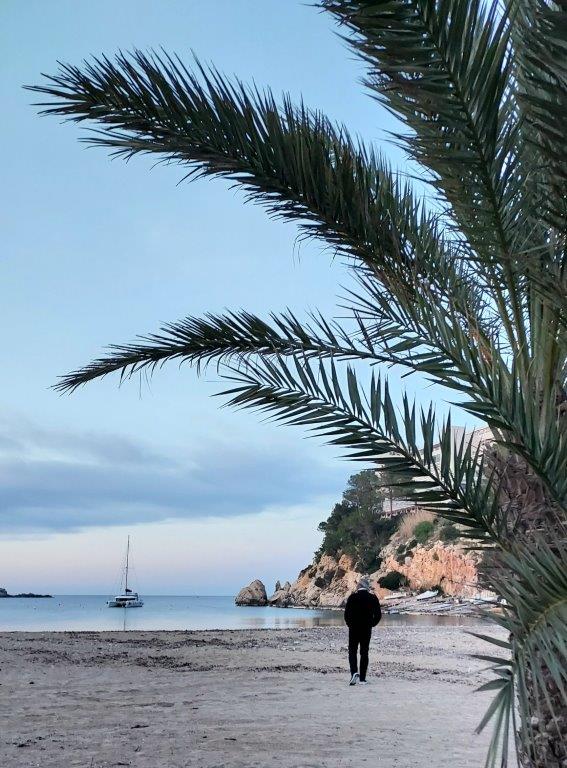

The water is so transparent, that you can see the bottom clearly. This is for example a bay of 6 meters deep and still you can see the rope of the mooringball so well!


At the very north of Ibiza you will find Portinatx, it’s a former fishing village situated at a small and idyllic bay. About 150 meters wide, with fine sand, crystal clear and very shallow water. We stayed here in the almost windless bay, at one of the white mooring balls in the water.
South of Ibiza
We also visited the south part of Ibiza, which is more busy, but now almost no tourists were there. We sailed to Cala d’Hort, we saw the beautiful and mysterious mountain Es Vedra.


It turned out that the westerly wind would not make it comfortable to anchor there. So we kept sailing for 20 minutes further south, when we suddenly saw this hidden bay between the rock walls! It’s a shallow bay about only 30 meters wide and max 10 meters deep which has a pebble beach. The bay called ‘Cala Llentrisca’ is enclosed by steep cliffs and about 5 fisherman’s huts built against the rock face. There are no facilities. During the day that we were here, 2 small empty fishingboats were anchored here, 2 locals were sunbathing on the beach and 4 kayaks passed by. It was 1 of our favorite bays at Ibiza!
Formentera
This island is located 7 kilometers south of Ibiza and is 19 kilometers long. Formentera is the number 4 inhabited island of the Balearic islands (after Mallorca, Ibiza and Menorca). The island is only accessible by boat. Famous writer Jules Verne described the island in his book “Journeys through the Solar System”, when he stayed at Formentera in the lighthouse of La Mola.

We anchored at Ses Illetes which is one of the most beautiful beaches of Formentera. Because of the narrow part of the island you have a beautiful natural phenomenon on this beach, namely the sea on both sides. Meters of white sand, infinite blue water and views of Ibiza and Es Vedra. All together makes this truly a paradise place! And again, we were the only boat at anchor here. Even in February, we had the idea that we were in an atoll in the Indian Ocean: the turquoise color of the water and the white of the ring-shaped beach around us gave us that feeling.
Ibiza-town
The largest city and capital on Ibiza is Eivissa (in Spanish). When we sailed back from Formentera to Ibiza, we saw D’Alt Vila: the historic old center of Ibiza town, located on a hill.

We went to the harbor of Ibiza town and parked our boat between private yachts in gold and silver colors, so after the nature reserve at Formentera, we went to the ‘blingbling’ part of Ibiza 😊.
We went sight seeing and D’Alt Vila is really nice to visit! It is a pleasure to cycle around here, in the maze of narrow cozy streets! This is actually one of the oldest cities known in Europe.

After spending 10 wonderful days at Ibiza, it was time to prepare our next crossing: to Mallorca!


